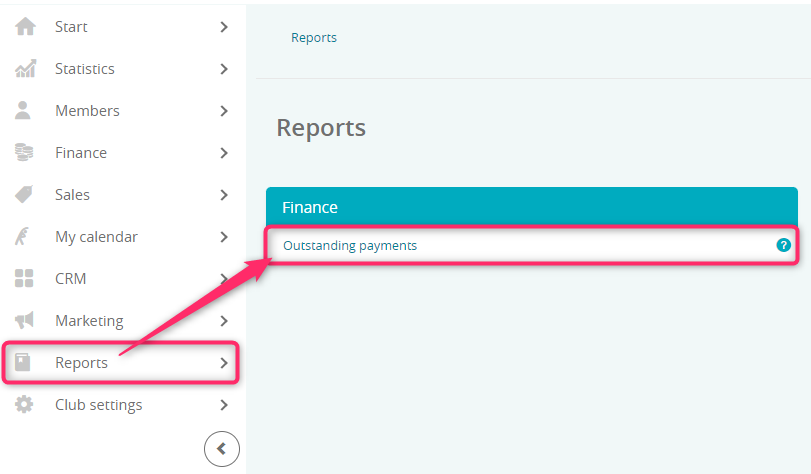The Outstanding payments report will help you check debts in installments as well as in fees. You can sort the report in general by arrears, by members and their total arrears, by payment forms and by memberships in which arrears are most frequent. This allows you to take effective dunning activities and see if changes to your sales offerings are necessary.
1. Where to find and how do the report look?
Move through the Reports -> Finance -> Outstanding payments:

2. What filters are available?
The following filters are available:

A) Club – filter available for clubs in chain
B) Report type – there are 4 options to choose from as described in this article below
C) Range of report – select the date range that includes the term of payment of the overdue installment
D) From/To – select the date range that includes the term of payment of the overdue installment
E) Status – the Outstanding payments report only shows members with three statuses: Active: Debt, Ex: Debt and Employee
F) Sales staff – member’s sales staff
G) Membership signed dat from/to – date of adding the membership on the member’s profile
H) Type – possibility to check arrears separately for installments and fees
I) Payment form – payment form assigned to the membership
J) Fees – possibility to check arrears for specific additional fees
K) Membership – possibility to check arrears for specific memberships
L) User – employee adding the membership to the member’s profile
M) Tags – ability to check arrears for specific tags assigned to members
N) Activity – possibility to check arrears by the number of entries of members
O) Gender – possibility to check arrears by gender
P) Accrual document – possibility to check arrears by issued accrual documents
3. What columns are available in the report?
After selecting the filters and clicking the Search button, a summary is available and the search results are visible in a table with columns.

Different columns in the table are displayed for different report types:
A) List of overdue payments – with this type the results are sorted by arrears, which are not summed up, so if one member has not paid two installments, they will be displayed in this view in two separate rows

- Club – club where the membership was sold
- Card number – member card number
- Last name, first name – member whose installment or fee has not been paid
- Status – member status
- Membership – name of the membership with arrears
- Membership signed – membership sale date
- Installment settlement period – installment settlement period according to the membership definition
- Installment price – membership installment price
- Term of payment – term of payment indicated with the installment
- Days outstanding – number of days after term of payment
- E-mail – e-mail address entered in the member’s data
- Phone number – phone number entered in the member’s data
You can also choose additional columns like:
- Member ID – member’s system number
- Payment form – payment form assigned to the membership
- Member ID – member ID entered in the member’s data
- City – city entered in the member’s data
- County – county name entered in the member’s data
- Postal code – postal code entered in the member’s address details
- Street – street name entered in the member’s address data
- House number – house number entered in the member’s address information
- Adress line 2 – further street name entered in the member’s address data
- Bank account number – member’s bank account number
- Bank name – member’s bank name
- Name of bank account owner – name of the member’s bank account owner
- Adress of bank account owner – address of the member’s bank account owner
- Wallet – funds on the member’s wallet
- Agreement no. – member’s system membership number
- Membership from/to – expiration dates of the member’s membership
- Details of the member’s mailing address
- Age – member’s age
- Gender – member’s gender
- Sales staff – member’s sales staff
- Agreement signed by – employee who sold the membership
- Document number – number of the member’s personal document
B) Group by members – with this type the arrears are summed up, so if one member has not paid two installments, they will be displayed in this view in one row, and their arrears will be summed up

- Club – club where the membership was sold
- Card number – member card number
- Last name, first name – member whose installment or fee has not been paid
- Status – member status
- E-mail – e-mail address entered in the member’s data
- Phone number – phone number entered in the member’s data
- Outstanding payment – summed up columns Total installments and Total charges, member’s total arrears
- Total installments – summed up values of unpaid installments according to the term of payment
- Total charges – summed up values of unpaid fees according to the term of payment
- Number of installments – number of unpaid installments according to the term of payment
- Number of charges – number of unpaid fees according to the term of payment
You can also choose additional columns like:
- Member ID – member’s system number
- Member ID – member ID entered in the member’s data
- City – city entered in the member’s data
- County – county name entered in the member’s data
- Postal code – postal code entered in the member’s address details
- Street – street name entered in the member’s address data
- House number – house number entered in the member’s address information
- Adress line 2 – further street name entered in the member’s address data
- Wallet – funds on the member’s wallet
- Data on the mailing address of the club member
- Sales staff – member’s sales staff
C) Group by payment form – using this type, the results are sorted by the payment forms that are set in the memberships with arrears. The values are summed up for a payment form

- Club – the club where the membership was sold with this payment form
- Payment form – payment form name
- Outstanding payment – amount of arrears in PLN
- Outstanding [%] – percentage amount of arrears
- Number – number of overdue installments/fees
- Number [%] – percentage value of overdue installments/fees
D) Group by membership – using this type, the results are sorted by the memberships with arrears. Values are summed for a membership (membership names)

- Club – club where the membership was sold
- Membership – sold membership name
- Outstanding payment – amount of arrears in PLN
- Outstanding [%] – percentage amount of arrears
- Number – number of overdue installments/fees
- Number [%] – percentage value of overdue installments/fees
